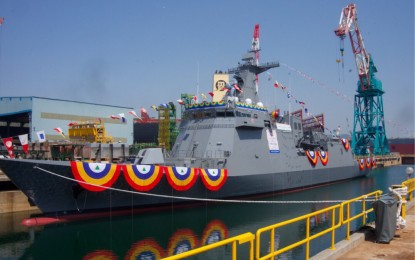
Press Pool photo
ULSAN, South Korea -- The top official of the Philippine Navy (PN) on Thursday described as a strategic move the commissioning of the missile frigate, BRP Jose Rizal (FF-150), which was formally launched at the Hyundai Heavy Industries (HHI) shipyard in this city on Thursday.
PN flag-officer-in-command, Vice Admiral Robert Empedrad, said the ship will be the most powerful unit in the PN inventory as it is armed with sensors and weapons capable of detecting and neutralizing any incoming surface, sub-surface and air threats aside from having the capability to engage in electronics warfare.
"It is a strategic move as this ship will be the most powerful in the PN due to its multiple capabilities," Empedrad said when asked by reporters on what the Rizal-class frigates can bring in terms of capability to the Navy.
The PN chief said the ship, which is expected to be delivered to the Philippines by HHI in September 2020, will be armed with an Oto Melara 76mm Super Rapid main gun, an Aselsan SMASH 30mm remote-controlled secondary cannon, anti-submarine torpedoes, and anti-air and ship missiles.
It is also equipped with a Hanwha Systems' Naval Shield combat management system (CMS), which integrates all shipboard sensors and weapons, and decides which is ideal to deal with any incoming threat.
The system can also detect and track some 4,000 targets and is used in various configurations by the Republic of Korea Navy, Royal Malaysian Navy, and the Indonesian Navy.
When asked if the BRP Jose Rizal and its sister ship, the BRP Antonio Luna, whose keel was also formally laid down at Dock 4 of the HHI's Ulsan shipyard on Thursday, can patrol the West Philippine Sea and the Philippine Rise, Empedrad replied in the affirmative.
"Of course. This ship is a big ship. It can patrol the West Philippine Sea, even the Philippine Sea. It can even go into the Pacific Ocean. It is a very stable ship. Acquisition of this class of frigate is a good decision for the PN," he added.
The Philippines and South Korean shipbuilder HHI signed a PHP16-billion contract for two missile-armed frigates. PHP2 billion was also set aside for its weapon systems and munition in October 2016.
Navy spokesperson, Capt. Jonathan Zata, said these frigates will help secure the country's maritime chokepoints or primary sea routes used for trade, logistics, and naval operations for all forms of threats.
Steel-cutting for BRP Jose Rizal took place on April 1 last year while the same ceremony for the BRP Antonio Luna transpired in November that year.
This event officially signified the start of the actual construction of the frigates.
Meanwhile, the keel-laying ceremony for BRP Jose Rizal took place in October last year as the formal recognition of the start of the ship’s construction.
Keel-laying refers to the official start of the construction of a ship and is considered among the four highlights of any surface vessel with the other three being steel-cutting, commissioning, and decommissioning
"These frigates are built based on the Incheon/FFX-I/HDF-3000-type multi-purpose frigate of the Republic of Korea Navy (RoKN), which offers increased operational performance and enhanced survivability," Zata said.
They are fully equipped with surface-to-air and surface-to-surface missiles, torpedoes, launchers and weapon systems for four-dimensional warfare.
The ship measures 351 feet long and 46 feet wide and has a maximum speed of 25 knots. It can travel up to 4,500 nautical miles at a cruising speed of 15 knots and can sustain operational presence for 30 days.
It can also withstand rough sea conditions up to Sea State 7, which means waves of up to six to nine meters high.
"Each frigate has a complement of more than 100 officers and crew. It has a flight deck towards the stern with the ability to handle one maritime helicopter weighing up to 12 tons. Two rigid-hulled inflatable boats will be carried to conduct military and emergency operations at sea," Zata added. (PNA)
